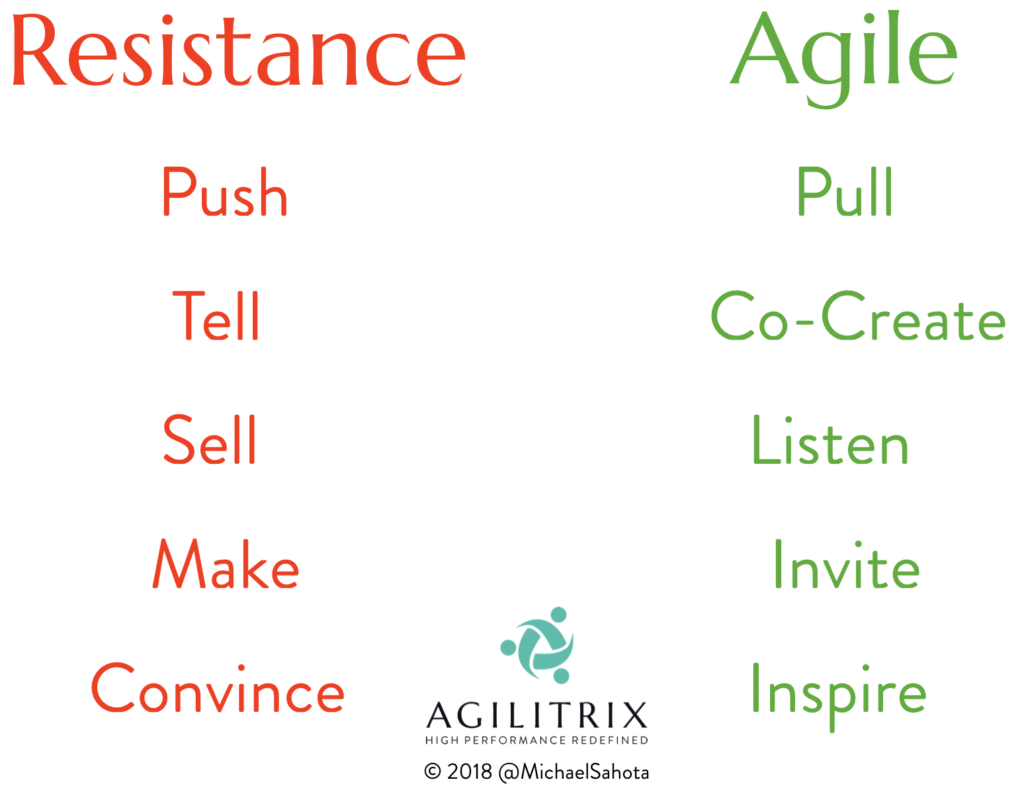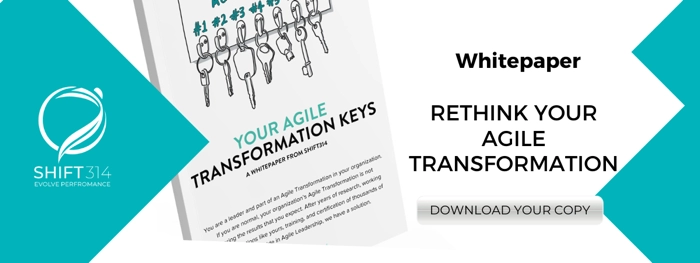Almost all Agile Transformation program experience resistance from managers, workers, other departments, etc. In this post, we will explain why you are experiencing resistance and how to eliminate or reduce it. Why are we experiencing resistance to Agile? Isn’t it about making people’s work environments better so they can be productive? Let’s assume for a moment that Agile is a good idea. Then what is going wrong with how we introduce it into organizations?
Push creates Resistance
The key challenge with “transformation as usual” is that change is pushed onto people without their involvement in the decision. And they resist that. We define a model called the Red List Mindset to capture the essence of how people push to create resistance.
Red List Mindset
There are many ways to create resistance that are variations of push. As you read the words below, think about how it feels for you when someone in authority behaves that way towards you:
- Drive
- Mandate
- Tell
- Sell
- Make
- Convince
For most people, these words will not feel comfortable. We don’t like it when people tell us what to do. We don’t like it when someone makes us do something. We don’t like it when people try to sell us something or convince us of their point of view. When these things happen to us, we resist it.
Agile Transformation Anti-Patterns
It turns out everyone else has the same response that we do. The more we push, the more resistance that we create. Here are some key anti-patterns to help you understand how we author our own failed Agile Transformations by creating resistance:
- Mandated Whole Organization/Department Change. Lot’s of people see this as a great success: “Hurray, everyone has to do Agile now”. But the victory is hollow and short-lived as this soon turns into a widespread case of “Cargo Cult Agile” where many people do the practices but nothing has really changed except the names.
- Agile Evangelism. I still encounter a lot of people in our Leadership trainings that see themselves as Agile Evangelists. The positive aspect is the desire to make things better. The negative or destructive aspect is to sell and convince. This creates resistance and damage that usually outweighs the positive. Every successful change program I have seen was about more than Agile. See: Why Workshop for more information.
- Agile Metrics (The Agile Police). Another well-intentioned approach that goes horribly wrong in practice to measure how “Agile” teams are and set targets for them to become “More Agile”. What this tells people very clearly is that Doing Agile is more important than Being Agile. You have to do Agile if you want to succeed around here or get your bonus. What this signals is that the process is more important than the people – the exact opposite of Agile.
Agile is about Pull
When you go to the core of what Agile is really about – it is based not on Push but on Pull. Like Lean, Scrum teams pull work they can complete in the next Sprint. Kanban teams pull tickets when they are ready.
Push Cannot Create Pull
How can we use a push approach to create an environment that supports Pull? It doesn’t make any sense. The evidence shows that using push simply doesn’t work. Sure, we might be able to create something that on the surface looks like it’s working. However, something different is needed to actually get the deep shift in behaviour the motivated, engaged people that is needed for pull to work. We create the model Green List Mindset to capture the behaviours related to pull.
The Green List Mindset
Similar to the list we had for push, we can create the opposite list for pull. As you read through the words below, think how they feel:
- Invite
- Listen
- Inspire
- Co-create
For most people, these words will feel positive. That’s the effect we want to create in organizations to foster success. We like it when we have freedom to choose. We like it when people invite us and it is optional for us. So we can decide for ourselves. We like it when people listen to us about what we want. It feels really good when we are inspired and excited about something. We like it when we get to be involved in decisions that impact us. Can you imagine how effective your change will program will be when people feel this way?
Pull Success Patterns
It is much easier to see what we are doing wrong than to look at what we are doing right. Let’s look at some key success patterns using pull. If you are not familiar with these, or are skeptical, we invite you to run an experiment to try them out.
- Listen. Most people want to be successful. Most teams want to be successful. One big challenge is that we often don’t take the time to listen to people about what they want and think. Take the time to listen to people about what they want. And help them with they want. List to them first, before telling them what you think or want. You will get a lot further.
- Go Where the Energy Is. The way to create a widespread success is to make small successes and build on them. Work with the people or teams that actually want help right now. Give them the help they want (listen) and make them successful. After time other people or teams may be ready or they may see what is happening and want it too.
- Co-Create Solutions. Agile is about collaboration, right? Isn’t it obvious if we are following an Agile approach we will collaborate with people on the transformation itself? I like the term co-create since it is about having people impacted by change be involved with the change. This is similar to the approach advocated by Lean Change and Open Space Agility. One difference in what I have seen work is that notice that managers and executives also need to be involved in this process alongside workers. Of course, that usually entails training for managers so they learn how to give away power in ways that help and do not harm.
Push vs. Pull – Green List vs Red List
The following image is helpful for comparing and contrasting the choices we have when working with people and teams on our Agile Transformation programs.  A key challenge to shifting our mindset to this new way of working (Agile) is that it feels uncomfortable. In particular, we often have a low skill level with the pull words. Really take time to see how you may inadvertently create resistance using the push words. Once we understand that the push words really do not work, it may give us the courage to be a novice operating using a pull model. And there is a lot more to say about operating in a people-friendly (pull) way, so if you think this isn’t the whole story, you are correct.
A key challenge to shifting our mindset to this new way of working (Agile) is that it feels uncomfortable. In particular, we often have a low skill level with the pull words. Really take time to see how you may inadvertently create resistance using the push words. Once we understand that the push words really do not work, it may give us the courage to be a novice operating using a pull model. And there is a lot more to say about operating in a people-friendly (pull) way, so if you think this isn’t the whole story, you are correct.
Agile is about People
The core of Agile is about “People over Process”. The key success pattern at the core of Agile is that success comes when we pay more attention to people than process. Most Agile Transformation get this backwards and focus on process. The usual push behaviours are a clear demonstration that most “Agile Transformations” are not really about Agile at all.
Wave2Agile
We need a fundamental rethink of Agile to overcome todays challenges. We are calling this reinvention Wave2 of Agile. It means putting people first. Inviting change. Dropping the destructive push behaviours. It isn’t about making anyone do this. It’s about us a leaders starting with ourselves to model the behaviours we want to see in others. Are you ready to join Wave2Agile?
What to do Tomorrow
- Notice where other people are using push behaviour and how it impacts you.
- Notice where you are using push behaviour and how it is creating resistance.
- Increase your “Agile/Pull” activities and see how people respond.
Where to learn more
- Learn more about our Certified Agile Leadership Training, or
- View all Upcoming Trainings!



